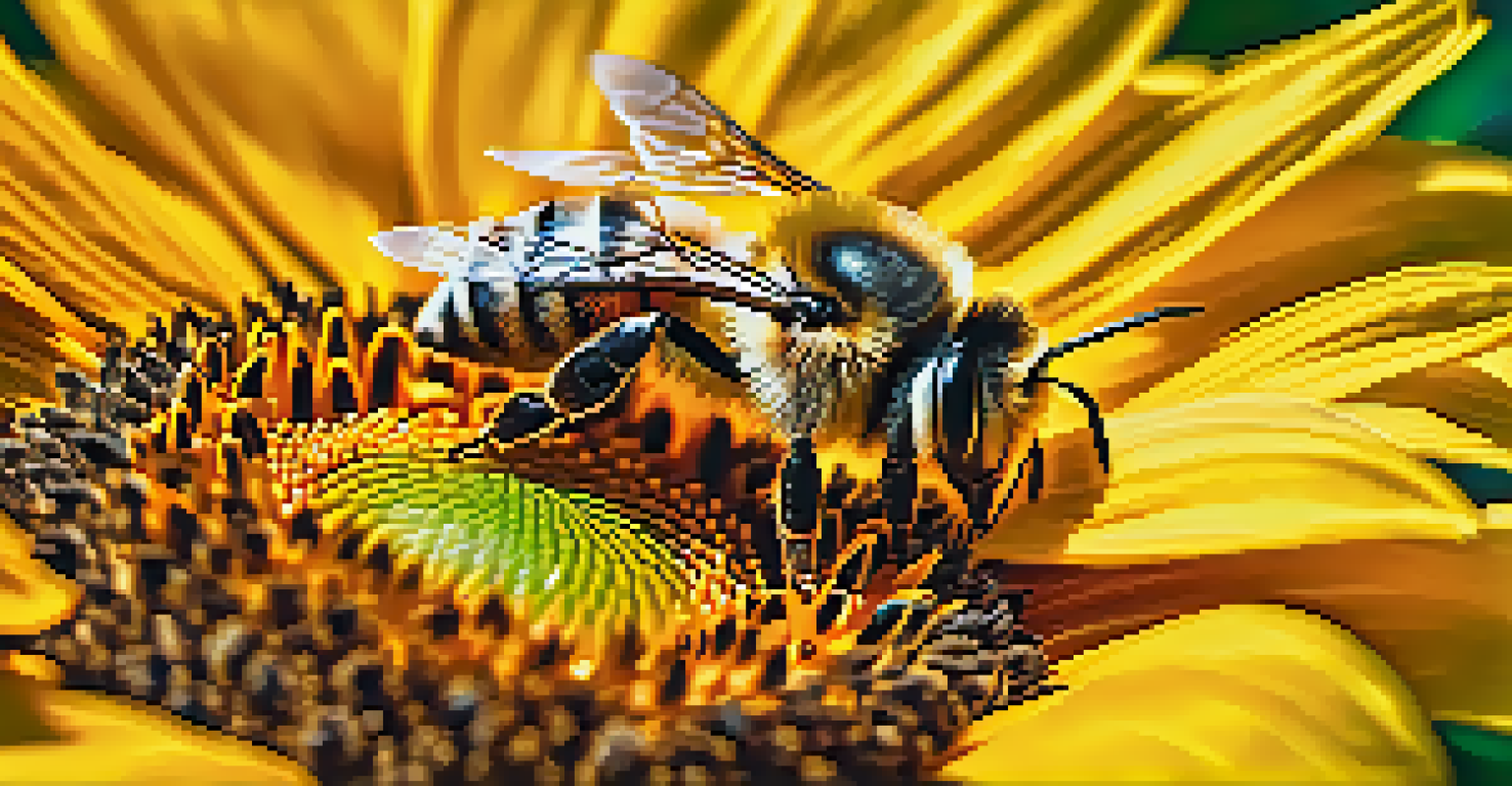Understanding the Pollination Process and Plant Survival

What is Pollination and Why is it Important?
Pollination is the process of transferring pollen from the male parts of a flower to the female parts, leading to fertilization. This natural phenomenon is crucial for the reproduction of many plants, allowing them to produce seeds. Without pollination, many plants would struggle to survive, which could disrupt entire ecosystems.
Pollination is a key ecological process that supports biodiversity and food production.
Many of our favorite fruits, vegetables, and nuts depend on pollination. For instance, without bees and other pollinators, we wouldn't enjoy strawberries, apples, or almonds. This relationship highlights the importance of pollinators in maintaining food security and biodiversity.
In essence, pollination not only aids in plant reproduction but also supports various wildlife that rely on these plants for food and habitat. The health of our planet's ecosystems hinges significantly on this delicate process.
The Role of Pollinators in the Ecosystem
Pollinators come in many forms, including bees, butterflies, birds, and even bats. Each of these creatures plays a unique role in the pollination process, contributing to plant diversity and the overall health of ecosystems. For example, bees are known for their efficiency and are responsible for pollinating around one-third of the food we consume.

As pollinators move from flower to flower, they inadvertently help plants reproduce. This interaction is a beautiful example of nature's interconnectedness, where different species rely on one another for survival. Without pollinators, many plants would not thrive, leading to a cascade of negative effects throughout the food web.
Pollination Supports Ecosystem Health
Pollination is essential for plant reproduction and biodiversity, impacting food security and wildlife habitats.
Moreover, pollinators help maintain genetic diversity among plants, which is essential for adapting to changing environments. This genetic variation allows plants to withstand diseases and pests, making ecosystems more resilient.
Types of Pollination: Self vs. Cross-Pollination
There are two primary types of pollination: self-pollination and cross-pollination. Self-pollination occurs when pollen from a flower fertilizes its own ovules, while cross-pollination involves pollen being transferred from one flower to another. Both methods have their advantages and disadvantages, influencing plant survival strategies.
Bees and other pollinators are critical to the survival of many plants, and we must protect their habitats to ensure a thriving ecosystem.
Self-pollination can be beneficial in stable environments where plants don't need genetic variation to thrive. However, relying solely on this method can make plants vulnerable to diseases. On the other hand, cross-pollination encourages genetic diversity, enabling plants to adapt better to environmental changes.
In many cases, plants have evolved mechanisms to promote cross-pollination, such as producing different types of flowers or attracting specific pollinators. This strategy enhances their chances of survival in ever-changing ecosystems.
The Pollination Process: A Step-by-Step Guide
The pollination process begins when a pollinator visits a flower seeking nectar. As it feeds, pollen sticks to its body, and when it moves to the next flower, some of this pollen is transferred to the stigma, the female part of the flower. This simple act sets off a chain reaction that can lead to fertilization and seed development.
Once the pollen reaches the stigma, it germinates and grows a pollen tube down to the ovary, where fertilization occurs. This process can take several hours or even days, depending on the species. It's fascinating to think about how this tiny act can result in the growth of fruits and seeds that sustain life.
Diverse Pollinators Enhance Resilience
A variety of pollinators, from bees to birds, contribute to genetic diversity among plants, making ecosystems more adaptable.
After fertilization, the ovule develops into a seed, and the surrounding flower structures often transform into protective fruit. This transformation is vital for plant survival, as it allows for the dispersal of seeds, ensuring the next generation can grow and thrive.
Factors Affecting Pollination Success
Several factors can influence the success of pollination, including weather conditions, the availability of pollinators, and environmental changes. For instance, heavy rain can wash away pollen, while extreme temperatures can deter pollinators from foraging. These factors can significantly impact a plant's ability to reproduce.
Habitat loss and pesticide use also pose significant threats to pollinator populations. When natural habitats are destroyed, pollinators lose their food sources and nesting sites, leading to declines in their populations. This decline can create a ripple effect, impacting the plants that rely on them for reproduction.
Additionally, climate change is altering flowering times and disrupting the synchrony between plants and their pollinators. This misalignment can lead to unsuccessful pollination, threatening plant survival and biodiversity.
The Importance of Biodiversity in Pollination
Biodiversity plays a crucial role in effective pollination. The greater the variety of plants and pollinators in an ecosystem, the more resilient it becomes. Diverse ecosystems can better withstand environmental pressures, such as climate change and diseases, which can threaten both plants and their pollinators.
For example, in regions with diverse plant life, pollinators have multiple food sources, promoting healthier populations. This abundance allows for better cross-pollination and increases the chances of successful plant reproduction. It's a win-win situation for both plants and their pollinators.
Protect Pollinators Through Action
Planting native flowers and avoiding pesticides can significantly support pollinator populations and promote their survival.
Conserving biodiversity is vital for maintaining healthy ecosystems and ensuring the survival of various plant species. Protecting habitats and promoting sustainable practices can help preserve the intricate relationships between plants and pollinators.
How to Support Pollinators and Plant Survival
Supporting pollinators can be as simple as planting native flowers in your garden. Native plants are adapted to local conditions and provide essential food sources for pollinators. By creating a pollinator-friendly garden, you can contribute to the health of local ecosystems while enjoying the beauty of blooming flowers.
Avoiding the use of harmful pesticides is another crucial step in protecting pollinator populations. Opt for organic gardening practices that promote natural pest control and minimize chemical exposure. By being mindful of our gardening choices, we can create a safer environment for pollinators.

Additionally, educating others about the importance of pollination can help raise awareness and inspire collective action. Whether it's participating in local conservation efforts or simply sharing information with friends, every little bit helps in supporting the vital process of pollination and ensuring plant survival.